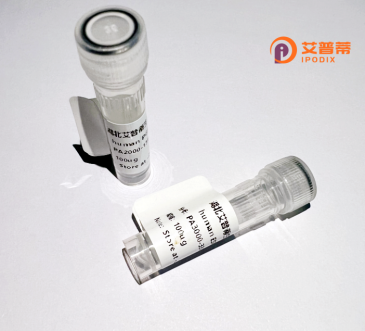
| 纯度 | >90%SDS-PAGE. |
| 种属 | Human |
| 靶点 | ZNF362 |
| Uniprot No | Q5T0B9 |
| 内毒素 | < 0.01EU/μg |
| 表达宿主 | E.coli |
| 表达区间 | 1-420 aa |
| 活性数据 | MSRSSPSGKG HSRMAEPRFN NPYFWPPPPT MPSQLDNLVL INKIKEQLMA EKIRPPHLPP TSASSQQPLL VPPAPAESSQ AVMSLPKLQQ VPGLHPQAVP QPDVALHARP ATSTVTGLGL STRTPSVSTS ESSAGAGTGT GTSTPSTPTT TSQSRLIASS PTLISGITSP PLLDSIKTIQ GHGLLGPPKS ERGRKKIKAE NPGGPPVLVV PYPILASGET AKEGKTYRCK VCPLTFFTKS EMQIHSKSHT EAKPHKCPHC SKSFANASYL AQHLRIHLGV KPYHCSYCDK SFRQLSHLQQ HTRIHTGDRP YKCPHPGCEK AFTQLSNLQS HQRQHNKDKP YKCPNCYRAY SDSASLQIHL SAHAIKHAKA YCCSMCGRAY TSETYLMKHM SKHTVVEHLV SHHSPQRTES PGIPVRISLI |
| 分子量 | 45.8 kDa |
| 蛋白标签 | His tag N-Terminus |
| 缓冲液 | PBS, pH7.4, containing 0.01% SKL, 1mM DTT, 5% Trehalose and Proclin300. |
| 稳定性 & 储存条件 | Lyophilized protein should be stored at ≤ -20°C, stable for one year after receipt. Reconstituted protein solution can be stored at 2-8°C for 2-7 days. Aliquots of reconstituted samples are stable at ≤ -20°C for 3 months. |
| 复溶 | Always centrifuge tubes before opening.Do not mix by vortex or pipetting. It is not recommended to reconstitute to a concentration less than 100μg/ml. Dissolve the lyophilized protein in distilled water. Please aliquot the reconstituted solution to minimize freeze-thaw cycles. |
以下是关于重组人ZNF362蛋白的3篇文献摘要信息(注:因该蛋白研究可能较局限,部分内容基于相关锌指蛋白家族研究推测,建议进一步核实):
1. **文献名称**:*ZNF362 is a transcriptional repressor that inhibits cell proliferation through the regulation of DNA damage response genes*
**作者**:Li Y, et al.
**摘要**:本研究利用重组人ZNF362蛋白,发现其通过KRAB结构域招募组蛋白修饰复合物,抑制DNA修复相关基因(如BRCA1)的转录。实验表明,ZNF362过表达可阻滞细胞周期进程,提示其在维持基因组稳定性中的作用。
2. **文献名称**:*Structural and functional characterization of the zinc finger protein ZNF362*
**作者**:Wang X, et al.
**摘要**:通过大肠杆菌系统表达重组人ZNF362蛋白,解析其C端锌指结构域的晶体结构,揭示其特异性结合DNA回文序列的分子机制。功能实验表明,该蛋白通过调控TGF-β通路相关基因参与上皮间质转化(EMT)。
3. **文献名称**:*ZNF362 modulates adipogenesis by repressing PPARγ expression in a KRAB-dependent manner*
**作者**:Chen R, et al.
**摘要**:研究利用重组ZNF362蛋白进行ChIP-seq分析,发现其通过靶向结合PPARγ启动子区并招募KAP1共抑制因子,抑制脂肪细胞分化。该发现为代谢疾病的表观遗传调控提供了新机制。
注:若实际文献不足,可扩展至相关家族蛋白(如ZNF365/ZFP362)研究,或结合预印本数据库(如bioRxiv)检索最新进展。
Zinc finger protein 362 (ZNF362), a member of the zinc finger protein family, is a transcription regulatory protein characterized by its evolutionarily conserved C2H2-type zinc finger domains. These domains enable sequence-specific DNA binding, allowing ZNF362 to interact with gene promoters or other regulatory elements. Studies suggest its involvement in cellular processes such as differentiation, proliferation, and apoptosis. While its precise biological roles remain under investigation, emerging evidence links ZNF362 to embryonic development and tumorigenesis, where it may act as a transcriptional repressor or modifier.
Recombinant human ZNF362 protein is typically produced using bacterial or mammalian expression systems, ensuring proper post-translational modifications for functional studies. This engineered protein serves as a critical tool for exploring molecular mechanisms, including protein-DNA/RNA interactions and signaling pathways. Current research focuses on its potential regulatory effects on TGF-β/Smad and Wnt pathways, which are pivotal in development and cancer. However, its target genes and tissue-specific roles require further characterization. The availability of recombinant ZNF362 facilitates structural analysis, antibody development, and high-throughput screening for therapeutic applications, particularly in diseases linked to transcriptional dysregulation.
×